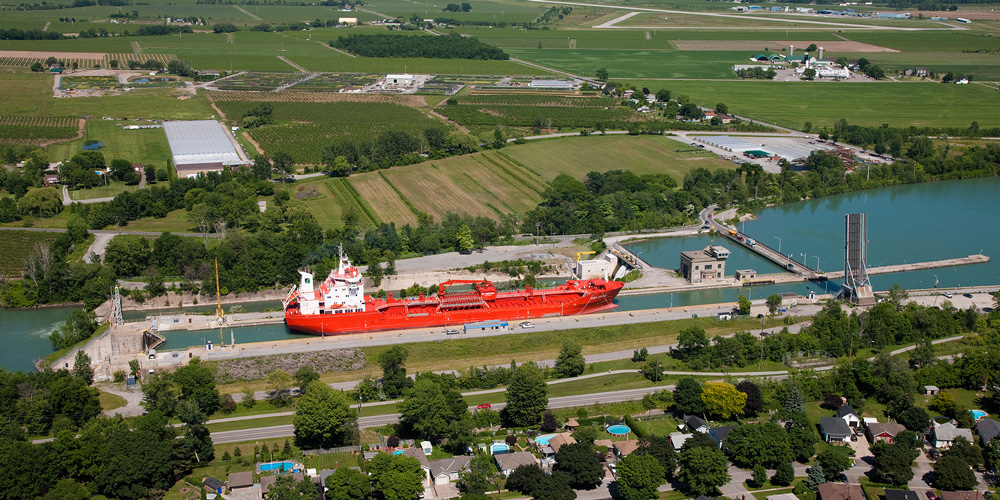Seaway Hits Post Recession High with 40 Million Tonnes of Cargo
January 12, 2015
Blowout Season in Grain; 12 Million Tonnes Shipped Highest since Turn of the Century
Cornwall, Ontario (January 12, 2015) – The Seaway concluded the 2014 navigation season with 40 million tonnes of cargo, which represents a full recovery from the 2009 global financial crisis and its ensuing aftermath. The St. Lawrence Seaway Management Corporation (SLSMC) announced today that the Seaway closed for the season on January 1, 2015, with the eastbound vessel Sten Bergen transiting the St. Lambert Lock in Montreal at 00:22 a.m. The last vessel to exit the Welland Canal was the Algoma Navigator at 8:00 a.m. on December 31. Given an opening date of March 28th (about a week later than usual, reflecting frigid conditions in early spring) the 2014 Seaway navigation season amounted to 280 days in length.
A blowout volume of grain moving through the Seaway was the standout feature of the season, as farmers and grain merchants furiously sought avenues to move the bumper crop from 2013 that had clogged rail lines. “There can be little question that the Seaway proved its value as a vital transportation artery in 2014” said Terence Bowles, President and CEO of the SLSMC. “Carriers moved over 12 million tonnes of grain through our locks, the highest volume since the turn of the century some 14 years ago. We are also pleased with our various marketing initiatives and toll incentives, to which we attribute about 2.5 million tonnes of new business during 2014”.
The rebound to 40 million tonnes of cargo in 2014, a 7% increase over the 2013 result, was principally due to the boom in grain shipments, accompanied by strong volumes of iron and steel products, and shipments of road salt to replenish inventories that had been severely depleted during the harsh winter of 2013. The influx of ocean vessels into the St. Lawrence Seaway was unprecedented in recent history. On multiple occasions in 2014, there were over 50 ocean vessels within the Great Lakes St. Lawrence Seaway System.
U.S. Saint Lawrence Seaway Development Corporation Administrator Betty Sutton said “The Great Lakes St. Lawrence Seaway System plays a strong role in facilitating economic growth throughout the Great Lakes Region, which is quickly becoming the ‘Opportunity Belt’ of North America. In particular, the increases in iron and steel cargo this shipping season reflect new growth in manufacturing, construction, energy and other industries throughout the region. The strong finish to the Seaway’s 2014 navigation season contributed to the resurgence in the overall economy and foreshadows a positive outlook for increasing use of maritime transportation to move goods throughout the region.”
During the 2014 navigation season, the SLSMC commissioned three additional locks with Hands Free Mooring equipment, bringing the total number of locks equipped with vacuum pads as a means of mooring ships to four. As part of the SLSMC’s five-year $500 million asset renewal and modernization program, the Seaway is forging the means for a waterway that is yet safer and more efficient. By the end of 2017, all Seaway high-lift locks will be equipped with the automated mooring equipment, eliminating the need to manually tie-up vessels using lines.
Likewise in 2014, Seaway carriers continued to modernize their operations, taking delivery of new state-of-the art vessels, purpose-built for Seaway use. Boasting sharp increases in fuel efficiency and reductions in emission levels, these new vessels are part of a billion dollar fleet renewal effort being undertaken by both domestic and ocean carriers. These investments underline the Seaway’s enduring value and the faith of key stakeholders in its future.
The St. Lawrence Seaway provides shippers with a cost effective and dependable transportation artery, providing a crucial means to ship cargoes to destinations both within North America and across the globe. Some 227,000 jobs and $35 billion in economic activity are supported by the movement of goods within the Great Lakes / Seaway waterway. For more information on the Seaway, please consult the www.greatlakes-seaway.com website.






